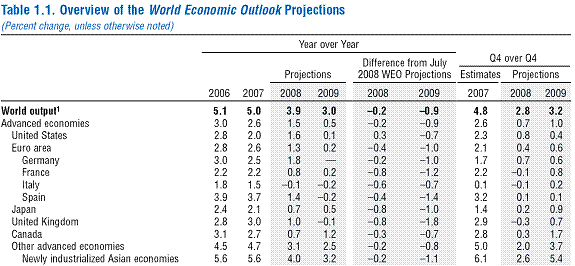From Chapter 1 of the IMF World Economic Outlook, released today:
The world economy is now entering a major downturn
in the face of the most dangerous shock in mature
financial markets since the 1930s. Against an exceptionally
uncertain background, global growth projections
for 2009 have been marked down to 3 percent,
the slowest pace since 2002, and the outlook is subject
to considerable downside risks. The major advanced
economies are already in or close to recession, and,
although a recovery is projected to take hold progressively
in 2009, the pickup is likely to be unusually
gradual, held back by continued financial market
deleveraging. In this context, elevated rates of headline
inflation should recede quickly, provided oil prices stay
at or below current levels. The emerging and developing
economies are also slowing, in many cases to rates well
below trend, although some still face significant inflation
pressure even with more stable commodity prices.
The immediate policy challenge is to stabilize global
financial markets, while nursing economies through a
global downturn and keeping inflation under control.
Over a longer horizon, policymakers will be looking to
rebuild firm underpinnings for financial intermediation
and will be considering how to reduce procyclical
tendencies in the global economy and strengthen supplydemand
responses in commodity markets.
Here is an excerpt from Table 1.1.

Table 1.1 from Chapter 1 of the IMF World Economic Outlook (October 2008).
Working off the 2008 q4/q4 growth rate, it appears the Fund is projecting an annualized -0.43% growth in 2008H2 for the US. These projections were based on data up through mid-September. Commenting on the implications of recent financial turmoil, the report continues:
…A worrying aspect of this latest bout of turbulence
is that there are now increasing signs that
market strains are starting to fall more heavily
on the nonfinancial corporate sector and on
emerging markets. If sustained, such strains
could well foreshadow a more severe macroeconomic
impact of the financial crisis than
previously anticipated.The nonfinancial sector in advanced economies
is now more broadly affected than during
the earlier stages of the crisis. Spreads on highgrade
nonfinancial corporate bonds, which have
risen gradually since the beginning of the crisis,
rose further during the latest round of turbulence
(first figure). They now stand at almost
double the 2002 peaks and indicate a default
risk comparable to that of emerging market
sovereign debt. Low-grade corporate spreads
also surged, but they remain below the historical
highs of 2002. Access to short-term financing
has tightened and equity prices have declined
(upper panel of second figure), although equity
prices still remain above previous troughs.
The recent surge in borrowing costs for
nonfinancial firms has taken place against
the backdrop of a gradual worsening of their
risk profiles over the course of the financial
crisis. The market-based measures of default
risk and leverage ratios have risen across the
credit spectrum in both the United States
and Europe — not only for low-grade bonds, as
would be expected during a slowdown, but for
high-grade bonds too (middle panel of second
figure). For high-grade corporate bonds in the United States, for example, the probability of
default has doubled since June 2007, although
it remains below the levels experienced in
2004, in part owing to strong corporate balance
sheets, particularly, ample internal funds.
Why are high-grade nonfinancial firms being
affected more severely during the current crisis
than during the previous major decline in
financial markets in 2000-02, following the collapse
of the dot-com bubble? A possible general
explanation relates to differences between the
shocks that triggered the respective downturns. The current downturn has its roots in the
financial sector, where the originate-to-distribute
model largely ceased to function. The financial
shock is being transmitted to the nonfinancial
sector via tighter financing conditions and,
more recently, a drying up of market liquidity.
The ubiquity of these channels leaves little room
for differentiation across the credit spectrum. In
contrast, the dot-com bubble originated in the
nonfinancial sector, notably high-yield corporate
credit, and was transmitted mainly through the
solvency channel, affecting low-grade nonfinancial
corporate bonds to an appreciably larger
extent than high-grade ones. A more specific
reason for increased pressures on high-grade nonfinancial firms relates to a growing concern
about their rollover risk during the current
crisis, because refinancing plans have led to a
bunching of maturing bond obligations over the
coming years, while bank financing has tightened.
Moreover, declines in equity prices have
increased the cost of raising capital. …
In other words, we are all Wall Street now…
Against this macroeconomic backdrop (in addition to financial sector rationales), the coordinated interest rate drops of 50 bps makes a lot of sense.
The report is extensive and well worth reading, even if some of the data is dated due to the extraordinary pace of events. Also see the IMF’s Global Financial Stability Report (Summary Report) .
Update 10/8 12:20pm Pacific: From Reuters, “Harvard’s Feldstein Says U.S. Recession to Be Longer Than Usual”.
Technorati Tags: recession, inflation,
financial crisis, consumption,
and IMF.